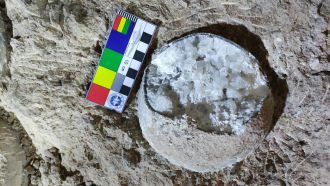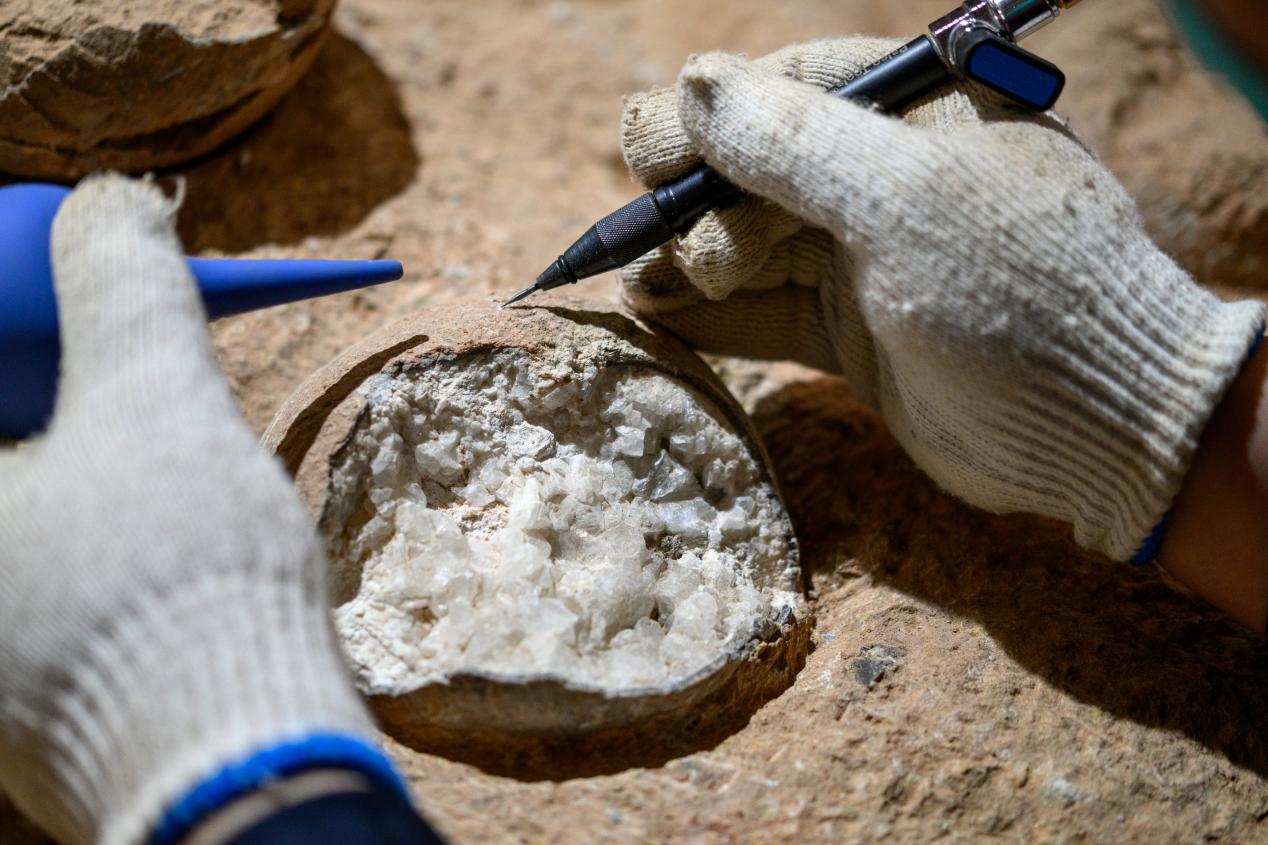Media release
From:
Newly dated 85-million-year-old dino eggs could improve understanding of Cretaceous climate
Scientists date dinosaur eggs that had laid buried in rock for millions of years for the first time, using new, ‘atomic clock for fossils’ method
Dating dinosaur eggs is difficult: available methods are limited and prone to errors because measurement proxies – such as volcanic rocks or crystals – may have changed between egg laying and dating attempts. Now, in a first for paleontology, researchers used a new method to date dinosaur eggs by firing lasers at eggshell fragments. This way, eggs in central China have been dated to the late Cretaceous, making them about 85 million years old. The findings could tell researchers about dinosaur populations and the climate millions of years ago.
In the Cretaceous period, Earth was plagued by widespread volcanic activity, oceanic oxygen depletion events, and mass extinctions. Fossils from that era remain and continue to give scientists clues as to what the climate may have looked like in different regions.
Now, researchers in China have examined some of them: dinosaur eggs found at the Qinglongshan site in the Yunyang Basin in central China. This is the first time that dinosaur eggs have been dated using carbonate uranium-lead (U-Pb) dating. The team published their results in Frontiers in Earth Science.
“We show that these dinosaur eggs were deposited roughly 85 million years ago, in the Late Cretaceous period,” said corresponding author Dr Bi Zhao, a researcher at the Hubei Institute of Geosciences. “We provide the first robust chronological constraints for these fossils, resolving long-standing uncertainties about their age.”
New dates
Qinglongshan is China’s first national dinosaur egg fossil reserve. There, more than 3,000 fossilized eggs are spread across three sites. Most fossils are embedded in different stones, such as breccias, breccia and siltstone mixes, and fine sandstones. The eggs have mostly remained in their original location and show only minimal deformation. The majority is thought to belong to a single species, Placoolithus tumiaolingensis, which belongs to the family Dendroolithidae, a group characterized by highly porous eggshells. The sampled calcite-filled dinosaur egg fossil came from a cluster of 28 eggs embedded within breccia-bearing siltstone.
To date the egg, the team used U-Pb dating. “We fired a micro-laser at eggshell samples, vaporizing carbonate minerals into aerosol. This is analyzed by a mass spectrometer to count uranium and lead atoms. Since uranium decays into lead at a fixed rate, we were able to calculate the age by measuring accumulated lead— it’s like an atomic clock for fossils,” Zhao explained.
The results showed that the eggs from this cluster were deposited around 85 million years ago, with the possibility of them having been deposited around 1.7 million years earlier or later. Their age means they’ve been laid during the Late Cretaceous, an epoch lasting from approximately 100 to 66 million years ago. They are the first reliably dated fossils from the Qinglongshan site.
Traditionally, dating dinosaur eggs involves indirect methods, such as dating volcanic rock, ash layers, or minerals around eggs. These, however, may have formed before or after the laying of the eggs, or geological processes may have altered them. The method used here allows for precise dating of eggs without having to rely on anything but the eggs themselves. “It revolutionizes our ability to establish global dinosaur egg chronologies,” Zhao said.
Old climates
Global cooling had started several million years before the laying of the eggs, in the Turonian epoch (lasting from approximately 93.9 to 89.8 million years ago). By the time they were laid, temperatures had declined significantly. The transition from a warm to a cooler climate was likely a factor in dinosaurs’ diminishing diversity and may have affected how many eggs were laid by how many species at Qinglongshan. “Dendroolithids’ specialized pore structures may represent evolutionary adaptations to this climatic shift, as novel egg types emerged worldwide during cooling,” Zhao said. The pore structure of Dendroolithidae eggs, which are markedly different from many other dinosaur eggs, may be one such adaptation. “P. tumiaolingensis may represent an evolutionary dead end where the egg-laying dinosaur population failed to adapt successfully to cooling climates,” Zhao explained.
Although few eggshell samples were examined in this study, all tests confirmed similar ages of egg fragments, which were also consistent with the age of the rocks surrounding the eggs. The team will be expanding sampling to include eggs found in different rock layers, which could help construct a regional timeline. They also said that Dendroolithid eggs in neighboring basins should be examined in the future to trace dinosaur migrations.
“Our achievement holds significant implications for research on dinosaur evolution and extinction, as well as environmental changes on Earth during the Late Cretaceous,” Zhao said. “Such findings can transform fossils into compelling narratives about Earth’s history.”
Multimedia









 International
International



